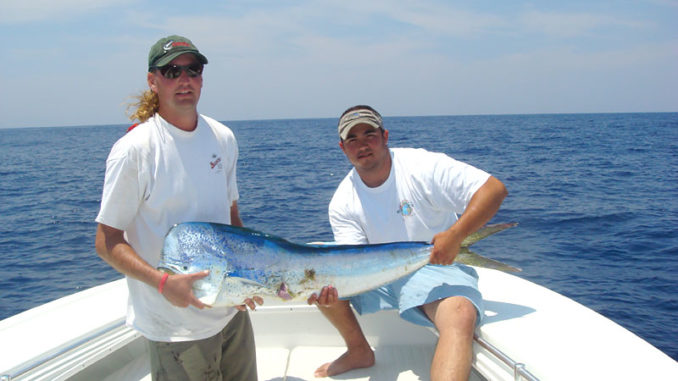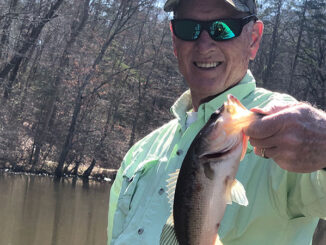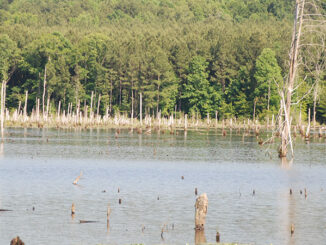
The chill of winter has set in, at least for much of the time, on the Carolina Coast. At this point in the year, my urge to be in the warm sun, well offshore of the crowds, kind of hits a fever pitch, most likely because it’s something that’s hardly attainable when I’ve just gotten through the holidays and there is college basketball on.
In my youth, I would head for South Florida for a few weeks right about the time that bluefin tuna season wrapped. But with family commitments and other work obligations, those days are well in the rear-view mirror. In the present, it’s more about early nights, getting my daughter ready for preschool on cold mornings, and doing my best to keep the house warm. Don’t be fooled by my domestic behavior, though. I’m still thinking about fishing.
January is the month where I’m planning my saltwater experience for the year and setting my goals.
I have one major saltwater goal for this year. I want to catch a gaffer dolphin on my 10-weight fly rod. Now, I’m not going to center all my fishing efforts around this solitary goal, but I’m going to make sure that when the time comes, I get to take full advantage of my opportunity. So, what does this entail?
For starters, I want my gear to be ready. With this being kind of a niche opportunity for me, I have a single fly rod, reel, and line that I have pieced together and put aside for this.
The rod is in perfect shape, the reel has been oiled, tested, and strung up with 400 yards backing under the line, with that knot triple checked. The rod and reel are staying in their case in a safe place on the boat until they are ready to be used. But I have practiced putting together in a hurry for when needed. I have tied a dozen fluorocarbon leaders just for this purpose and they are individually sealed in Ziploc bags.
I also have a full box of flies resembling anything I think a big dolphin might want to eat. Some I have attempted to tie myself, but most of them are tried and true patterns that I bought, mainly from a friend in Palm Beach, where fly fishing for dolphin is much more common. This fly box, much like the rod and reel, only comes out when it’s showtime. Assembling this gear and checking it out is a great way to kill time on a nasty weather evening after the kids go to bed, especially if you can light a fire in the fireplace.
Next, I want to strategize about how I’m going to find, bait, hook, and land this dolphin. By now, I’ve read every article I can find about how to catch big dolphin on fly tackle, so I have a template for success. I want to troll with the right outrigger stowed, with a full spread on the left side, and simply a flat line and a squid chain teaser on the right. Line is already stripped off the reel, the rod is at the ready, and when the right fish shows up on the teaser on that side of the boat, I must make a 3/4 angled cast to the fish as the captain of the boat is pulling the squid chain away from a “hot” fish, using a water haul to load the rod. Pretty simple, right?
Make it count
Better go talk to the captain at this point, along with a few others who are likely going to be on the boat that day. If everyone knows their part in the process before we leave the dock, our chance of success goes way up. Not to mention, I also have an excuse to talk about fishing when the weather dictates we are doing anything but actually fishing.
At this point all we need to do is plan based on the calendar. For something like this, it’s not like you can plan a specific day. We need a fairly calm, late spring day when concentrations of dolphin are in our waters. A light south wind would be ideal here. The best we can do right now is look at general times when we think this is going to work, then adjust when it gets close based on what we know and what we think the weather is going to do. In this case, mid to late May looks like our best bet. Time to try to set up my work schedule so that I’m fairly flexible right before Memorial Day and can go on the best weather days.
So, this is what I’m thinking when it comes to my goal. Your own goals might be drastically different. They could easily be much more vague, like “I want to become a better bottom fisherman” or “I want to be more productive on trips where I take my family fishing.” They could be focused on a specific event or series, like “I want to fish the Big Rock,” or “I want to enter the local redfish series and qualify for the championship.” They could be species specific, as in “I want to catch my personal best flounder” when the season opens in the fall.
Your goals can be exactly what you want them to be. The key is to use the forced down time of winter to do your homework and formulate a plan. Use every resource available to you off the water to learn about new techniques, gear, and the patterns of the specific fish you want to target. Study old logbooks and you’ll be amazed at how many of these patterns reveal themselves. Go through your terminal tackle, make it bulletproof, and have backups ready to go as well. We only get a short window to target these fish when conditions are perfect. Use the time that you can’t go fishing at all to make those few shots count.
Always be ready:
Sometimes, the shot at achieving a life-long angling goal presents itself without warning. Without proper preparation, the moment is lost in an instant. Set your goals, then give yourself the best shot at success when the opportunity arises.




Be the first to comment